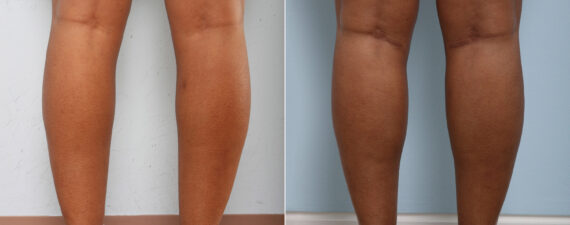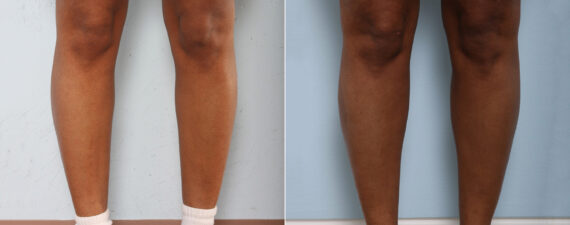Calf implants, designed to enhance calf appearance through cosmetic surgery, offer a potentially lifelong solution. However, their longevity hinges on various factors, including the materials and surgical techniques used.
Dr. Paul Vitenas, renowned for his expertise in body contouring procedures, emphasizes understanding these aspects for informed decisions. The material composition of calf implants significantly influences their lifespan. Additionally, surgical precision plays a vital role. This article will share insights into expected durability post-surgery, crucial for those considering calf implants.

Calf Implant Durability Insights
- Calf implants are generally designed to be permanent, with many lasting 20 years or more.
- Proper surgical technique and post-operative care can extend the lifespan of calf implants.
- Lifestyle choices and physical activities can impact the longevity of calf implants.
- Periodic check-ups with a plastic surgeon can help monitor and maintain the condition of calf implants over time.
- Despite their durability, calf implants may need replacement or adjustment due to natural aging or body changes.
Longevity of Calf Implants: Factors and Average Duration
The durability of calf implants depends on several key elements, including the following:
- Implant material quality.
- Patient lifestyle and activity.
- Adherence to post-operative care.
- Muscle definition maintained post-surgery.
One of the benefits of calf augmentation is that it is a long-term solution, but sometimes, individuals may need additional surgery. This is due to body changes over time, potential injury, or personal preference for altering the implant’s appearance. It’s crucial to understand the distinction between cosmetic surgery, aimed at improving appearance, and reconstructive surgery, which addresses medical needs by repositioning or changing current implants.
On average, patients may look into replacements or adjustments to their implants after a decade. To ensure the implants’ longevity, regular check-ups with a calf enlargement surgeon are crucial. With advancements in calf augmentation techniques and technologies, the expected lifespan of calf implants has improved.
Surgeons perform calf implant surgery through small incisions, with the goal of creating enduring results and minimal disturbance to the implants. Regular monitoring and consultation with your surgeon can help preserve the outcome of successful calf augmentation surgeries.
The Different Materials Used for Calf Implants and Their Impact on Longevity
The material used for calf enhancement has a great impact on their longevity and how realistic they feel. Plastic surgeons typically choose between two types of implants: solid silicone and silicone gel-filled.
Solid silicone is known for its durability and low risk of rejection. It can maintain its shape even during calf muscle movements. Silicone gel-filled implants, on the other hand, provide a more realistic texture and firmness similar to actual calf muscles.
Implant lifespan varies, influenced by personal lifestyle and adherence to post-surgery care. Discussing these aspects with your surgeon provides a clearer expectation for your calf implant procedure, considering the most common implant types: solid silicone and silicone gel-filled.
The Procedure’s Influence on the Lifespan of Calf Implants
Techniques for calf augmentation involve precision to promote implant longevity. Surgeons execute every incision with care, placing them strategically to safeguard the gastrocnemius calf muscles. The correct placement of incisions plays a vital role in determining the stable settlement of the implants, affecting their longevity.
Patients receive instructions for incision care after calf implant surgery. Following these closely is essential to prevent issues that can reduce the implants’ lifespan. Persistent body movements can put stress on the area, yet the surgeon’s methods are designed to integrate the implants well with the calf muscles, which can enhance their longevity when undisturbed.
The quality of materials used, along with the patient’s adherence to post-operative care and the recovery period, are significant factors in maintaining the calf implant’s function and aesthetic.
Strategies to Prolong the Lifespan of Your Calf Implants
Maintaining the condition of your calf implants involves collaboration with your surgeon and knowledge of connective tissue management in body contouring surgeries. To extend the lifespan of calf implant surgery, consider these practical steps:
- Adhere closely to the calf implant recovery guidelines provided by your surgeon.
- Keep all scheduled post-operation visits for progress checks and to address possible issues early on.
- For the first couple of days after surgery, avoid intensive physical activities that may harm the implants until your surgeon advises otherwise.
- Consult about medications before surgery that could aid in the healing process and improve the durability of your calf implants.
Employing these tactics can support enduring results from your calf implant surgery.
Signs of Aging Calf Implants: Identifying Issues and Taking Action
Calf implant surgery is generally durable, yet some individuals might notice changes that suggest it’s time for a revision calf implant consultation. Recognizing these signs early can be crucial:
- An implant that seems asymmetric or has moved
- Persistent pain in the implant area
- Skin wrinkling or folding over the implant
- A new feeling of hardness or stiffness
Also, muscle spasms in the calf could indicate complications. Any abnormalities in the incision with stitches, such as reopening or discharge, are warning signs and should prompt a consultation.
It’s essential to see a plastic surgeon experienced in calf implant surgery for advice on managing these issues and maintaining safe, effective results.
What to Expect from Calf Implant Revision Surgery
Calf revision surgery involves a series of steps to improve the appearance and feel of calf implants. The process starts with a consultation to set clear objectives. Pre-surgery, calf augmentation patients may need to make some health and lifestyle adjustments.
The surgery, under anesthesia, typically adjusts or replaces existing implants, with an effort to use previous scars for minimal new scarring. Recovery includes specific care instructions and activity limitations, with follow-up visits to check on healing.
Results develop over time, and physical therapy may be suggested to aid recovery. The aim of this surgery is to achieve a better fit and look for the implants, ensuring patient comfort and satisfaction.
If you’re considering calf implants and want to know more about their durability and how to maintain them, expert guidance is key. Scheduling a consultation with Dr. Paul Vitenas is an important step in making an informed decision. With his vast expertise, you can discuss the factors influencing the longevity of calf implants and the procedures.
Dr. Vitenas, a board-certified plastic surgeon in Houston, Texas, offers personalized care and a detailed approach to help achieve your aesthetic goals. His track record of patient satisfaction and awards speaks to his dedication to excellence in cosmetic surgery.


